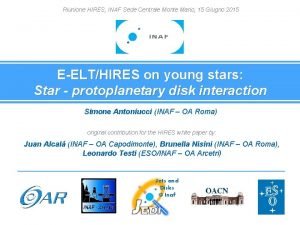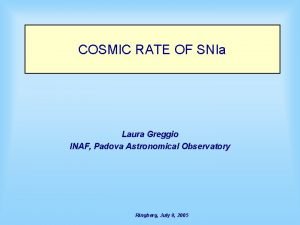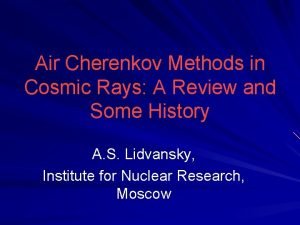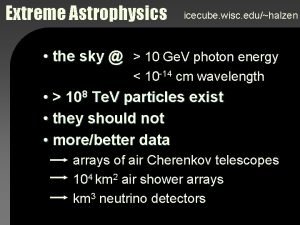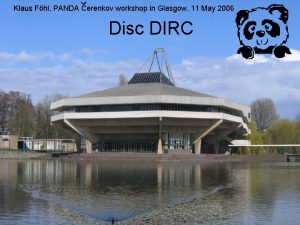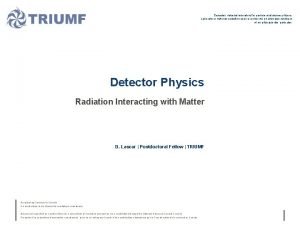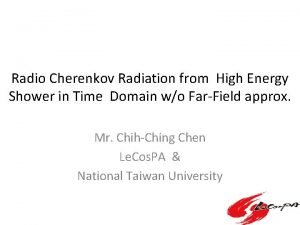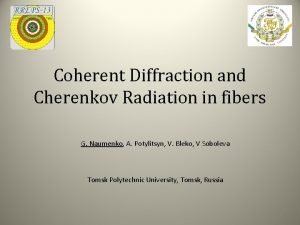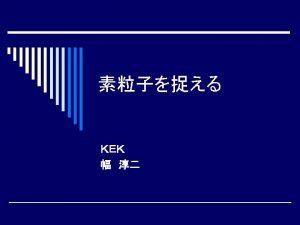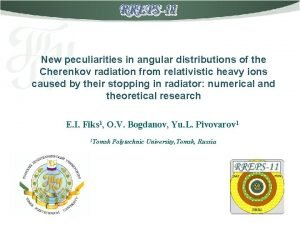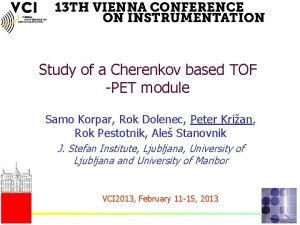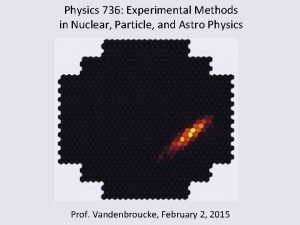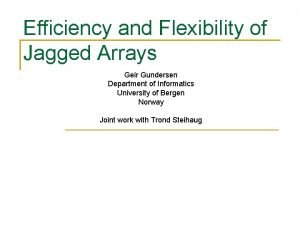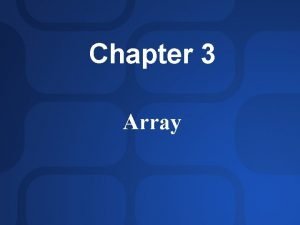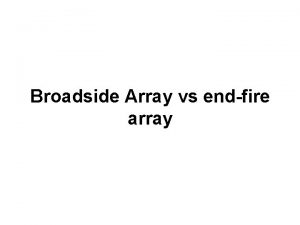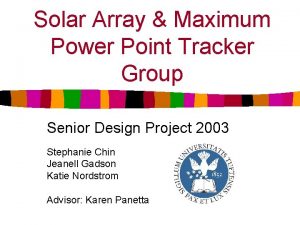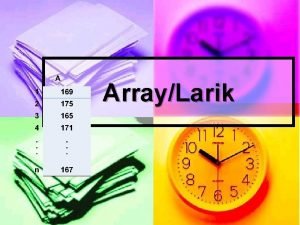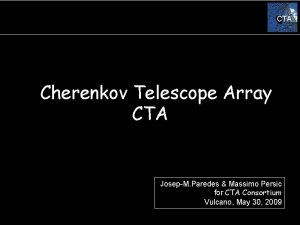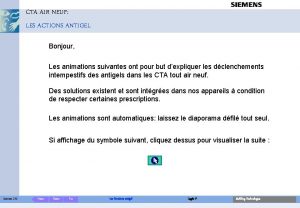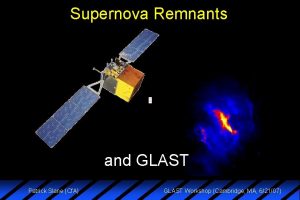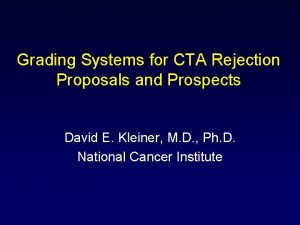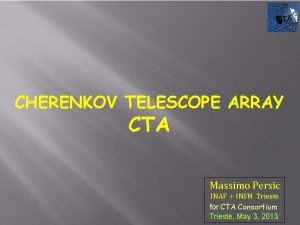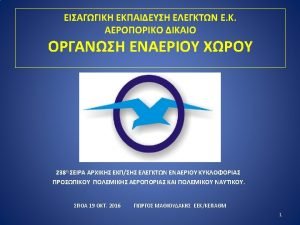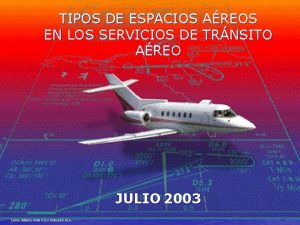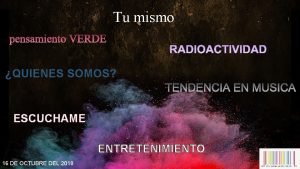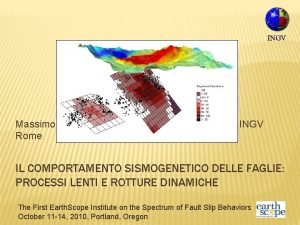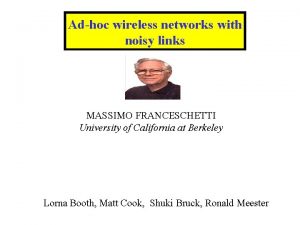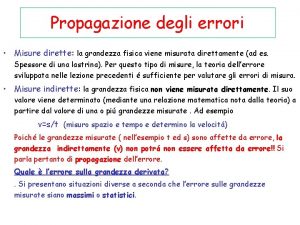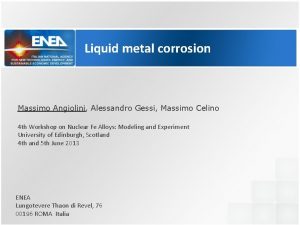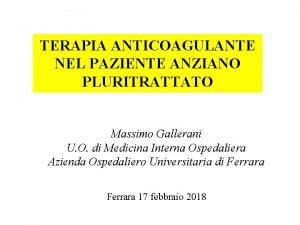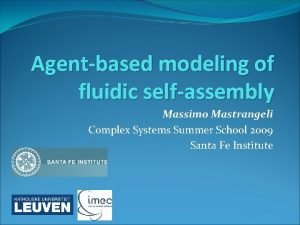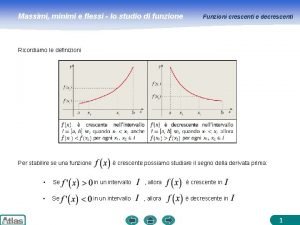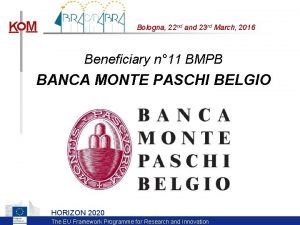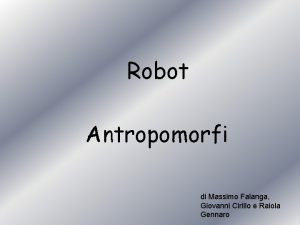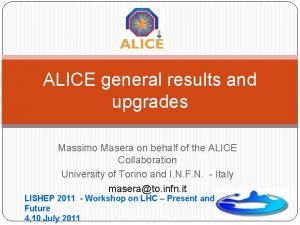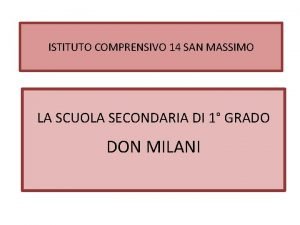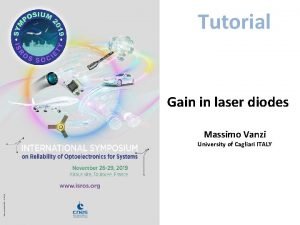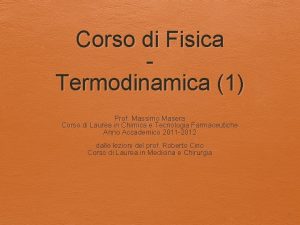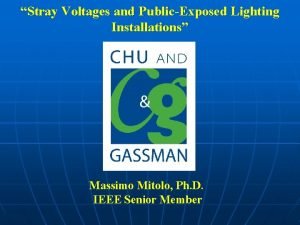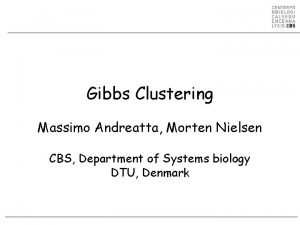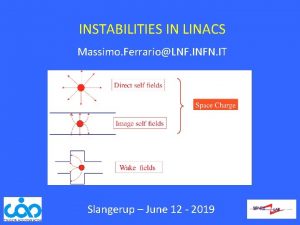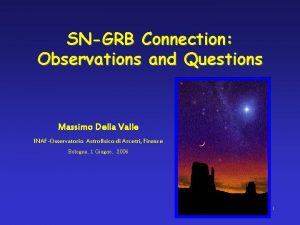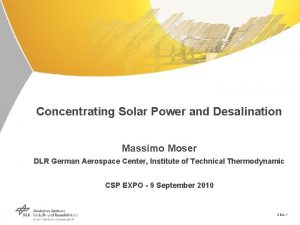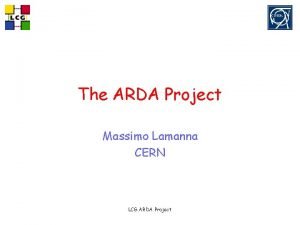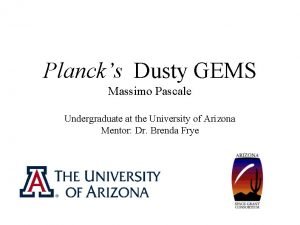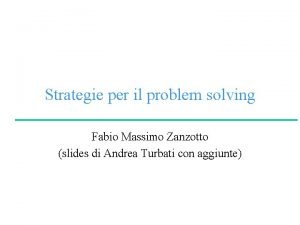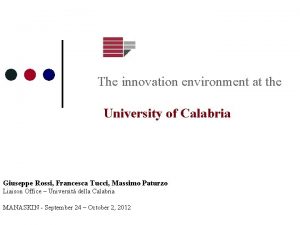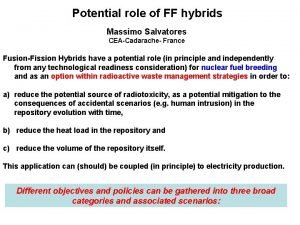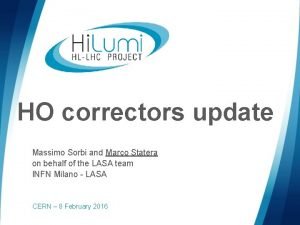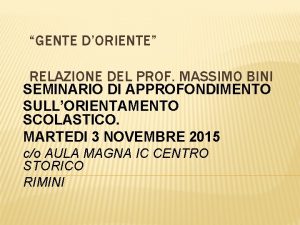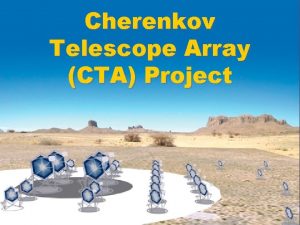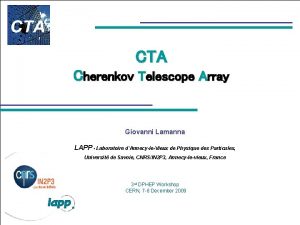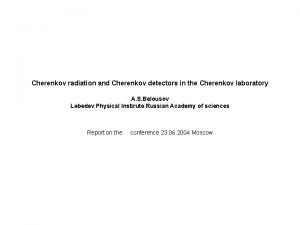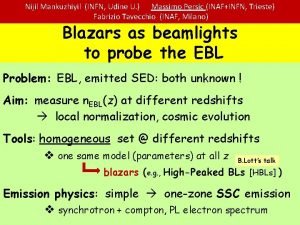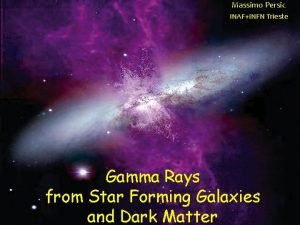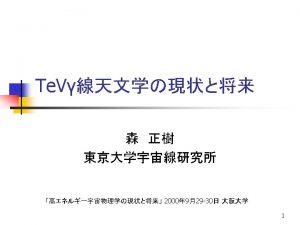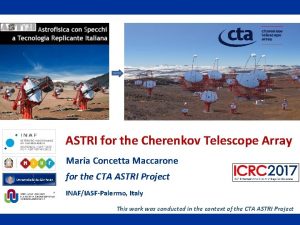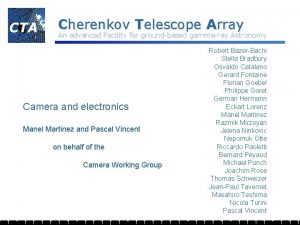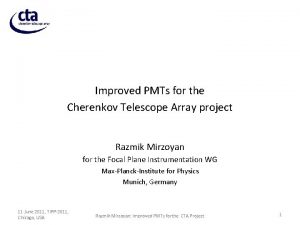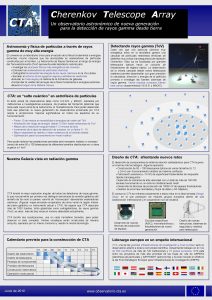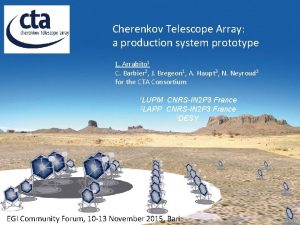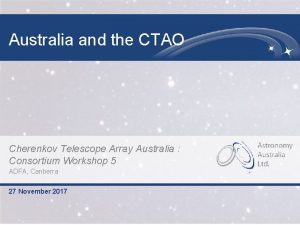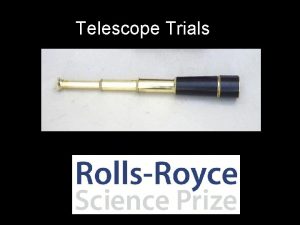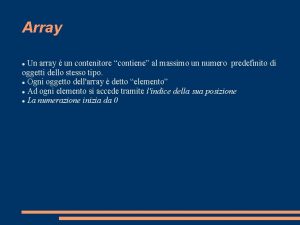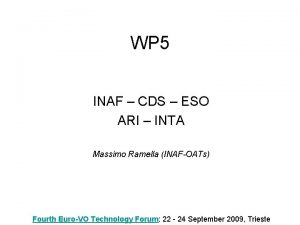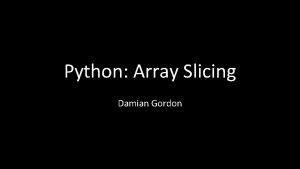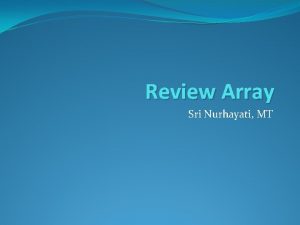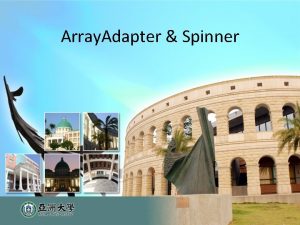CTA CHERENKOV TELESCOPE ARRAY CTA Massimo Persic INAF
















































































- Slides: 80

CTA CHERENKOV TELESCOPE ARRAY CTA Massimo Persic INAF + INFN Trieste for CTA Consortium Trieste, May 3, 2013

Outline � � � Ground-Based gamma-ray astronomy Physics questions left by the current instruments The Cherenkov Telescope Array � Sensitivity Requirements � Current Status & Design Study, e. g. Example MC simulation Location Studies � � � Possible Schedule CTA in Context Conclusions Credits to: A. De Angelis, J. Conrad, G. Hermann, J. Hinton, W. Hofmann, M. Martinez, M. Mariotti, D. Mazin, A. Moralejo, S. Nolan, S. Ritz, Th. Schweizer, M. Teshima, D. Torres CTA

Detection Method � � CTA Potentially 5 decades of energy accessible via this technique (~few Ge. V to few hundred Te. V) 1 decade of overlap with satellite

Ground Based γ-ray Astronomy CTA

Ground Based γ-ray Astronomy CTA

CTA

Current Status of VHE ap � � CTA The current generation of telescopes (H. E. S. S. / MAGIC / VERITAS) have detected >100 sources. Several more with HESS 2 / MAGIC 2 / upgraded VERITAS Stellar Winds Supernova Remnants Pulsar Wind Nebulae Binary Systems Molecular Clouds Galactic Centre No Counterpart/Dark Sources AGN Constraints on EBL Constraints on QG CR Electron Spectrum Regular observations made between 70 Ge. V-20 Te. V with few % Crab sensitivity

Science Potential Distance kpc SNR/PWN Mpc Gpc CTA adapted by Hinton fr Horan & Weekes 20 Blazars Starbursts Radio Gal. Binaries Pulsed Current Flux Sensitivity CTA Colliding Winds Clusters GRBs +Dark Matter Current instruments have passed the critical sensitivity threshold and reveal a rich panorama, but this is clearly only the tip of the iceberg What big science questions remain ?

Big Science Questions � Determining � Origin of � Whether � galactic cosmic-rays γ-ray binaries emit via wind/jet Studying � Star formation regions � Pulsars and PWN � Studying Physics of AGN Jets � Galaxy clusters: the dark side of � CTA structure formation. Constraining � Extragalactic Background Light � Quantum Gravity Energy Scale � � May detect WIMP annihilation Dark sources / New source classes

CTA tech wish list � Higher Sensitivity at Te. V energies (x 10) Deep Observations More Sources � Higher Detection Area Greater Detection Rates Transient Phenomena � Better Angular Resolution Improved morphology studies Structure of Extended Sources � Lower Threshold (some 10 Ge. V) Pulsars, distant AGN, source mechanisms � Higher Energy Reach (Pe. V and beyond) Cutoff region of galactic accelerators Sources of UHECRs? � Wide Field of View Extended Sources, Surveys CTA

… and a few open issues for CTA!. Spectral degeneracy at Te. V energies HESS J 1834 -178 uuu Hadr onic: AGIL E Fermi CTA M AG I C 2 M Ä o Lept np =6 f target g onic: c a B=10 m 3, L(0. s, exp-c 4 u m. G, exp- 6 Te. V)= toff proto cutof n 2 f elec. 5 E+34 e distrib: a=2. r tron 1, E distri g/s b: a= c =100 2. 0, Ec =2 0 Te. V D = 4 kpc VHE g-rays: hadronic or leptonic ? low Ethr (~10 -30 Ge. V) to discriminate CTA improved low-E coverage, solve spectral

Origin of Galactic CRs from SNRs J 1713. 7 -3946 CTA Leptonic: Ee ~ 20 (Eg )1/2 Te. V ~ 110 Te. V … but KN sets on. . ~100 Te. V Hadronic: Ep ~ Eg / 0. 15 ~ 30 / 0. 15 Te. V ~ ~ 200 Te. V = 105. 3 Ge. V Importance of improving statistics: 3 years of HESS data 1 year CTA: improved statistics at Eg > 100 Te. V, to probe CR knee

Gamma-Ray Bursts (GRBs) CTA · Most energetic explosions since Big Bang (1054 erg if isotropic) · Astrophysical setting unknown (hypernova? ) · Emission mechanism unknown (hadronic vs leptonic, beaming, size of emitting region, role of environment, … … ) · Cosmological distances (z >> 1) Missed naked-eye GRB 080319 B (z=0. 937) Gggg HESS MAGIC -------------------- CTA low Ethr ~ 20 Ge. V to see GRBs !! MAGIC ST

GRBs 080319 B missed obs of “naked-eye” GRB CTA Intrinsically: Nearby: z=0. 937 Brightest ever observed in optical Exceedingly high isotropicequivalent in soft g-rays Swift/BAT could have observed it out to z=4. 9 1 m-class telescope could observe out to z=17 Missed by both AGILE (Earth screening) and MAGIC (almost dawn) next BIG ONE awaited !!

AGN Short-term simultaneous SEDs of low-z blazars. Quiescent states of low/intermediate-z blazars. High states of high-z blazar. IAC T CT A CTA

CTA Mk 421 Flare of Mar/Apr 2008 Aleksic + 2012

PKS 1424+240 Prandini et al. 2012 detected by VERITAS, confirmed by MAGIC (2 CTA : w Ne 6. 0 z>

simultaneous 2011 archival Jan-Jun 2010 CTA

7 Telescope Array, Whipple, HEGRA, MAGIC z = 0. 048 2 n detected by AMANDA (1 during orphan flare) CTA 1 ES 1959+650 Backes + 2012 Regular monitoring 2005 -2011: 58 hr l SC S one de mo 1 -z 2 -zone SSC model Steady source. Rich non-simult. SED. l 1 - e zon EC de mo

Beyond blazars � CTA New generation IACTs have established new classes of VHE active galaxies different than blazars… Starbursts Blazars (BL Lacs): still the vast majority: ~40 — 15 discovered by MAGIC Extensive studies 2 — none discovered by MAGIC No central source, probably global emission of all CR in galaxy Quasars Radiogalaxies 4 — 2 discovered by MAGIC Study emission in jet: they are nearby (can be resolved in other wavelengths) and jets not aligned with line of sight. May be sources of UHECRs? 3 — 2 discovered by MAGIC Different physics: intense radiation fields. Very far: useful to study EBL

… Mk 501 Mankuzhiyil + 2012, Ap. J, 753, 154 CTA

… SSC parameters vs source activity: Mrk 421 CTA Mankuzhiyil, Ansoldi, MP, & Tavecchio 2011, Ap. J, 733, 14

Mk 501 Mankuzhiyil + 2012 CTA

Thomson vs. CTA extreme K-N scattering regime Thomson ext rem e. K l Mk 501 q Mk 421 -N

CTA PKS 2155 -304 (H. E. S. S. )

D A R K M A T T E R CTA

Small, nearby galaxies … or … large, faraway clusters? Let’s start from signal from self-interacting DM decay CTA D-2 small cosmology: distances best! guys win! d. Sph halos are best candidates for DM signal astrophysics: d. Sph stellar pops. are most silent astroph bkgd

Some background on galaxy structure. . I(r) = I 0 exp(-r/Rd) same profile at all luminosities! ies x a l a g 1000 + 1996 ic Pers CTA

CTA Rotation curves are not self-similar with luminosity!

CTA Smooth progression of RC shape, and disk/halo interplay, with luminosity Universal Rotation Curve of spiral galaxies Persic et al. 1996 blablablabl lkugkfthjfftrd

Tully-Fisher relation on i t ta o R rve cu Persic + 1996 R/Ropt when DM starts to be dynamically felt CTA

CTA Persic+ 1996

Whence these properties? � Bottom-up cosmology: small galaxies formed first, hence their density retains the cosmological density at the epch of their turnaround (dr/r 1. 8). CTA � Baryon infall: SF SN expl. winds most of infalling baryons lost in small gals. , but retained in bigger ones. � Smaller, denser gals. have little/no SF. Bigger, less dense gals. do have gas and SF.

Dwarf Spheroidals: ideal DM candidates CTA Milky Way satellites nearby High M/L DM dominated Old stellar pop. no ongoing SF

CTA

CTA

Example: Draco d. Sph modeling total DM annihil. rate g-ray flux upper limit d~80 kpc Bergström & Hooper 2006 CTA <s. Av>, mc: WIMP annihil. cross section, m Ng: g-rays / annihil. cusped profile cored profile g-ray flux part. phys astrophys rs = 7 – 0. 2 kpc r 0 = 107 – 109 Mž kpc-3 r 02 rs 3 = 0. 03 – 6 Mž 2 kpc

CTA

t+t- bb tt min. cored W+ WZZ max. cusped Bergström & Hooper 2006 MAGIC 40 -h exp. _ _ CTA Fermi LAT 1 -yr exp. IACT neutralino detection: <s. Av> ³ 10 -25 cm 3 s-1 Stoehr + 2003

CTA

… present status CTA

Weniger’s line? CTA

Weniger’s line in CTA? kgfgtfkfkgkgkhgvkgv CTA

CTA

CTA

CTA

DM: future status uld o w d, RB e t G c e E t If de roduce rp ove CTA

Conclusions on DM CTA

Evolution of cosmic star formation rate CTA’s higher-E extension (e. g. 50 Te. V) will allow us to probe poorly known sub-mm EBL. CTA Franceschini et al. 2008

CTA

Probing Quantum Gravity CTA

Kjbvakj CTA EQG ~ 0. 05 MP Major improvements expected from CTA and $ no conventional explanations

CTA

CTA

CTA

CTA

CTA

CTA

CTA

field of view CTA angular resolution

CTA

CTA

CTA

CTA

CTA

CTA

CTA sensitivity tyuujunas CTA hjv

CTA Design started ! CTA Expected Design Study Results � � � Detailed knowledge of characteristics, availability of a few good site candidates. Array layout which optimises physics performance for a given cost (and which is about 1 order of magnitude better than we have now). Detailed design and industrial cost estimates for telescopes and associated equipment Plan how to organise, produce, install commission, operate the facility; estimate for operating cost Model and prototype how to handle and analyse the data Small prototype series of common components, to ensure that production issues and costs are understood.

CTA

CTA

CTA Cost per telescope, complexity Lesson from MC: Hard to beat telescope numbers & area covered Big challenge: cost effective production and high reliability Expect best overall science performance about here Performance

Possible CTA sites CTA

Site choice � CTA How to compare different sites? Issues include � � � Astronomical quality Infrastructure cost Access Risks … � In the end, it basically boils down to a cost argument: For a given budget, which site will provide best sensitivity? � E. g. higher access cost at a remote site will imply fewer telescopes, compensating a possible gain in observation time … of course, quantifying everything may be hard … �

Cost � CTA Given for ESFRI: 150 M€ investment cost (in 2006) � 100 M€ south site � 50 M€ north site � Escalates to about 190 M€ for 2013 -2018 construction period � Update only once we have semi-realistic numbers � What if there is not enough funding secured at t 0? � An issue for the Resource Board …

Operating costs � � � Typical facilities require annual operating costs of 7% to 10% of investment cost For CTA this would imply 13 – 19 M€ per year For 500 CTA scientists, this is 25 -40 k€ person � � CTA About 10 x more than current instruments Major concern for (some) funding agencies Need to � Understand operating costs very well � Minimize operating costs Is >10 M€ operating costs plausible?

Contributions to operating costs � Personnel � � � Utilities � � Site services (rooms, food, …) Site & building maintenance Instrument maintenance � � � Power Telecommunications Infrastructure � � � Management User interfacing & proposal handling Shift operation Instrument maintenance Data centers & user support Mirror recoating Photosensor replacement Travel … No n- ex ha us tiv el ist CTA

CTA : The Observatory � � � CTA will be a normal astrophysical observatory, open to the community, with professional operators, A 0 s and support for data analysis. Data will be public after some time (1 year ? ) 50% of observation time for construction consortium CTA

CTA: In Context CTA Space-based instruments only UV | X-ray | g-ray | VHE g-ray 10 -11 Integral More sensitive 10 -12 Fermi GST Current Instruments 10 -13 10 -14 XMM 10 -15 HST 10 -16 1 e. V 1 ke. V 1 Me. V 1 Ge. V 1 Te. V 1 Pe. V Energy n. Fn (erg cm-2 s-1) optical

Summary � � � The current generation of ground-based γ-ray telescopes have provided a wealth of information on many new sources Many open physics questions remain CTA aims to answer many of these, and provide an observatory for the wider astrophysical community Highly ranked in many European roadmaps The design study is underway CTA

CTA Thanks!
 Xe @150
Xe @150 Laura greggio
Laura greggio Cherenkov light
Cherenkov light Cherenkov
Cherenkov Cherenkov radiation
Cherenkov radiation Cherenkov radiation
Cherenkov radiation Cherenkov radiation
Cherenkov radiation Cherenkov radiation
Cherenkov radiation Cherenkov
Cherenkov Cherenkov spectrum
Cherenkov spectrum Cherenkov radiation
Cherenkov radiation Cherenkov radiation formula
Cherenkov radiation formula Cherenkov
Cherenkov Cherenkov light
Cherenkov light Cherenkov spectrum
Cherenkov spectrum Effetto cherenkov
Effetto cherenkov Jagged array vs multidimensional array
Jagged array vs multidimensional array Sparse array adalah array yang
Sparse array adalah array yang Associative array vs indexed array
Associative array vs indexed array Array 2 dimensi python
Array 2 dimensi python Pin grid array vs land grid array
Pin grid array vs land grid array Difference between broadside and endfire array
Difference between broadside and endfire array Photovoltaic array maximum power point tracking array
Photovoltaic array maximum power point tracking array Char b 6 6 6 dengan alamat awal
Char b 6 6 6 dengan alamat awal Larik adalah
Larik adalah Cta freedom
Cta freedom Cta.myleave
Cta.myleave Control fisico
Control fisico Cta
Cta Cta bus 4
Cta bus 4 Ctc cta
Ctc cta Cta liberty
Cta liberty Cta download
Cta download Antigel cta
Antigel cta Cta
Cta Cta grading
Cta grading Cta goodman
Cta goodman Mi cta
Mi cta California tamil academy books
California tamil academy books Cta
Cta Athinai fir
Athinai fir Atz ctr
Atz ctr Agm salud cta
Agm salud cta Cta templates
Cta templates Massimo ligazzolo
Massimo ligazzolo Massimo cocco
Massimo cocco Massimo franceschetti
Massimo franceschetti Propagazione degli errori
Propagazione degli errori Massimo angiolini
Massimo angiolini Massimo ciocca
Massimo ciocca Massimo gallerani
Massimo gallerani Massimo mastrangeli
Massimo mastrangeli Minimi massimi e flessi
Minimi massimi e flessi Massimo grassi unipd
Massimo grassi unipd Colored pencil techniques worksheet
Colored pencil techniques worksheet Massimo bencardino
Massimo bencardino Massimo falanga
Massimo falanga Iteenary
Iteenary Istituto comprensivo san massimo
Istituto comprensivo san massimo Massimo vanzi
Massimo vanzi Massimo masera
Massimo masera Massimo mitolo
Massimo mitolo Massimo galli
Massimo galli What are 3 domains
What are 3 domains Santi tiburzio valeriano e massimo
Santi tiburzio valeriano e massimo Massimo ferrario infn
Massimo ferrario infn Massimo della gamma
Massimo della gamma Massimo biasotto
Massimo biasotto Massimo lamanna
Massimo lamanna Massimo moser
Massimo moser Massimo lamanna
Massimo lamanna Massimo pascale
Massimo pascale Zanzotto tor vergata
Zanzotto tor vergata Massimo mariano psicologo
Massimo mariano psicologo Massimo paturzo
Massimo paturzo Massimo masera
Massimo masera Massimo salvatores
Massimo salvatores Massimo sorbi
Massimo sorbi Massimo bini professore
Massimo bini professore Linguaggio di programmazione cruciverba
Linguaggio di programmazione cruciverba Massimo cirasino
Massimo cirasino
